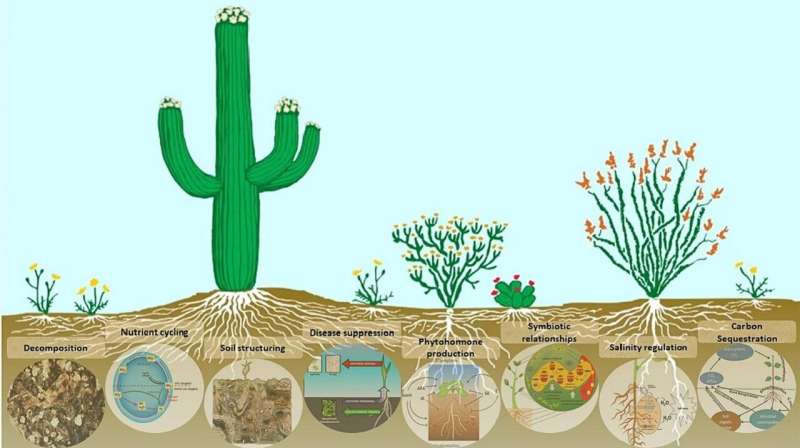Desertification poses a grave threat to ecosystems and communities in arid and semi-arid regions worldwide, leading to the transformation of once fertile lands into barren deserts. The detrimental effects of desertification, driven by both natural processes and human activities, include soil erosion, loss of biodiversity, and diminished agricultural productivity. In the face of this escalating environmental crisis, there is an urgent need for effective management strategies to mitigate its impacts and restore degraded landscapes. Recent research has shed light on the pivotal role of soil microorganisms in combating desertification, offering promising avenues for sustainable land management and ecosystem restoration.
Understanding Desertification: Causes and Consequences Desertification arises from the intricate interplay of climatic changes and human interventions that disrupt the delicate balance of arid ecosystems. Climate factors such as rising temperatures, altered precipitation patterns, and extreme weather events exacerbate soil degradation and vegetation loss, accelerating the desertification process. Anthropogenic activities, including deforestation, intensive agriculture, overgrazing, and unsustainable land use practices, further exacerbate soil erosion and degradation, exacerbating the vulnerability of affected regions. The consequences of desertification are far-reaching, impacting biodiversity, food security, water resources, and human livelihoods, and necessitating urgent intervention to reverse its detrimental effects.
Unveiling the Role of Soil Microbes in Desertification Management In a comprehensive review published in Earth-Science Reviews, researchers highlight the indispensable contributions of soil microorganisms in mitigating desertification and promoting ecosystem resilience. Soil microbes, including bacteria, fungi, archaea, and other microscopic organisms, form a diverse community that plays multifaceted roles in enhancing soil health and fertility. By decomposing organic matter, cycling nutrients, sequestering carbon, and stabilizing soil structure, soil microbes exert profound influences on ecosystem dynamics and sustainable land management practices. Recognizing the potential of soil microorganisms as powerful allies in the fight against desertification opens new avenues for innovative approaches to restoration and rehabilitation efforts.
Harnessing Microbial Diversity for Desertification Management The efficacy of soil microbes in combating desertification lies in their ability to perform a myriad of functions that contribute to soil fertility and ecosystem stability. Nitrogen-fixing bacteria, such as Rhizobium and Bradyrhizobium, facilitate the conversion of atmospheric nitrogen into plant-available forms, thereby enhancing plant productivity and soil fertility in nutrient-depleted environments. Symbiotic relationships between mycorrhizal fungi and plant roots extend the reach of nutrient acquisition, improving water and nutrient uptake efficiency and promoting plant growth in arid conditions. Moreover, soil microbes play a crucial role in carbon sequestration, with fungi producing glycoproteins like glomalin that bind soil particles and enhance soil structure, mitigating erosion risks and enhancing soil stability.
Success Stories and Case Studies: Microbial Applications in Desertification Management Across diverse ecosystems and geographical regions, strategic application of soil microbes has yielded promising results in combating desertification and promoting ecosystem resilience. From mining remediation sites to agricultural landscapes and urban environments, microbial interventions have demonstrated their effectiveness in restoring degraded soils and enhancing ecosystem functionality. Projects such as China’s “Grain for Green” initiative and Africa’s Great Green Wall exemplify large-scale efforts to leverage soil microbial communities for land rehabilitation and sustainable development. By engaging local communities and integrating traditional knowledge with scientific innovation, these initiatives showcase the transformative potential of microbial-based solutions in addressing complex environmental challenges.
Challenges and Future Directions While the potential of soil microbes in desertification management is evident, several challenges and considerations warrant attention. The variability of microbial responses to environmental stressors and site-specific conditions underscores the importance of tailored approaches and ecosystem-based management strategies. Long-term sustainability and resilience of microbial interventions require continued research efforts to elucidate microbial dynamics, optimize microbial inoculants, and assess ecosystem responses over time. Moreover, interdisciplinary collaboration and community engagement are essential for ensuring the success and scalability of microbial-based solutions in diverse socio-ecological contexts.
Soil microorganisms emerge as powerful allies in the quest to combat desertification and restore degraded landscapes. By harnessing the diverse metabolic capabilities and ecological functions of soil microbes, we can unlock innovative pathways towards sustainable land management and ecosystem resilience. From restoring biodiversity and enhancing soil fertility to mitigating erosion and promoting climate resilience, soil microbial communities offer invaluable contributions to addressing the multifaceted challenges of desertification. As we navigate the complexities of environmental change and human impacts, embracing microbial-based solutions holds promise for forging a more sustainable and resilient future for arid ecosystems and communities worldwide.
